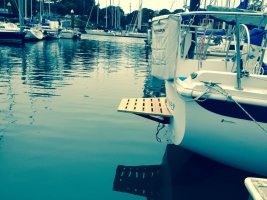No doubt you are correct if I sailed the Great Lakes or ocean....Factory states 1 hour at maximum power..that's 6 miles at full power using mid quality house batteries and no solars.
However, Alan just for friendly argument sake...my boat is an Ericson sailboat...vast majority of the time, engine time is warming up, then under 1k rpm for 125 yards or so getting out of the marina, then up goes one or both sails....with an electric motor to use the equivalent of 6 miles at full power...I would need to charge once every couple of months! My pier does have shore power however.
Also I am on a large lake...therefore according to my diesel fuel usage in and out of the marina...now use about 2-3 gallons a month at maximum; most of that engine time is for warming it up from cold..and extra 30-40 minute runs every 10 days at 75%+ power, just to keep the moisture out of the oil/engine for long life. Nothing worse for an engine is a short run...be it a car, boat or airplane.
Interesting how many folks with sailboats on inland lakes (or coastal waters) use their engines only for getting in and out of marinas, to the fuel pumps or loading their palpable water tanks...and running their engines for longer periods just to keep them in condition. How often do folks change engine oil and oil filters and check their oil level, not to mention fuel filters and air filters...or just purging water out of their fuel filters. Or constantly monitoring their bilge for evidence of antifreeze/oil..and almost go into cardiac arrest when something shows... Or even worse, after leaving the marina for home..question.."oh my gosh, did I shut off the sea water thru-hull valve to the engine"?? Or, oh my gosh, started the engine and noticed no water out the exhaust...forgot to open the engine thru-hull raw water valve!"
How many folks take great care where they obtain their fuel ? Many marina fuel stations are rarely used, seldom change service pump filters and deliver poor fuel. Diesel engines are spoiled rotten...they get the best care, best fuel, long run times or inevitably become problematic at the worse times. Been there and done it.
Again, just for friendly argument sake. My Diesel engine is very low time and will most likely last 2 lifetimes. I am just an old school green old person who drives a trouble free 10 year old Prius with 128k miles that averages 51 mpg and the only service is annual oil/filter changes. Always drive in eco mode.
Alan...it's your turn!! Smile.....!



 ), and cruised up and down the Sound heaps all while electric. Almost hard to remember, it was 15k nm ago! Being electric was never an issue there. In fact we had more trouble with engine failure prior to repowering. Cinderella sails like a dream though, even with her 90's era sails.
), and cruised up and down the Sound heaps all while electric. Almost hard to remember, it was 15k nm ago! Being electric was never an issue there. In fact we had more trouble with engine failure prior to repowering. Cinderella sails like a dream though, even with her 90's era sails.